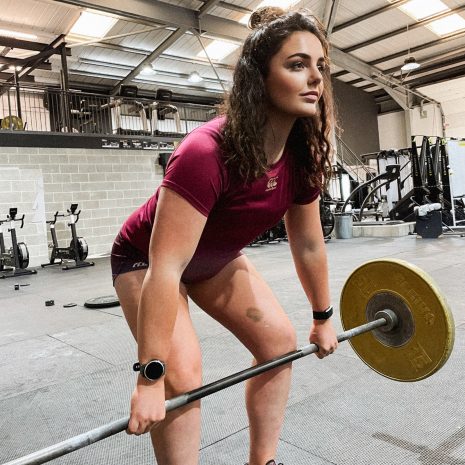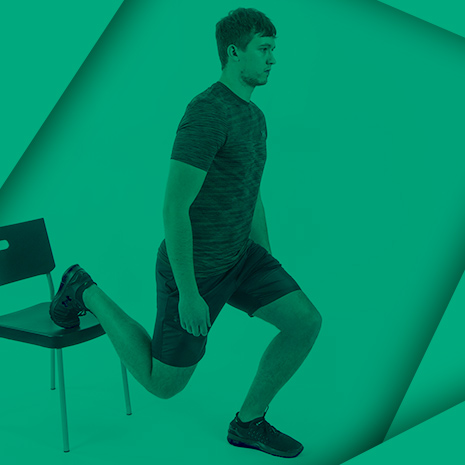We’ve teamed up with esteemed Chartered Physiotherapist, Neil Aitken to give you high-quality information on the most common rugby injuries and how to best recover from them. If there’s a particular injury you’d like us to cover with Neil’s help, get in touch with us on social media (Facebook | Twitter).
Quick links
- What are the symptoms of groin strain?
- What is a groin injury?
- How long do you rest a groin strain?
- Is ice or heat better for a pulled groin muscle?
- How long does it take to recover from a groin strain?
- The best exercises and stretches for your groin

What are the symptoms of groin strain?
You will feel a sharp pain on the inside of the thigh, either in the muscle belly or up at the top of the groin where the tendons meet the pelvis. It will be sore to walk. Swelling is not usually visible. Bruising may appear a few days after the injury and may track down the leg.
What is a groin injury?
It is typically where you tear some or all of the muscle fibres in one of the 5 groin muscles. Like all muscle injuries, this can be graded from 1 to 3. A grade 1 strain is where some fibres are injured but it is fairly minor. A grade 2 involves more muscle fibres, the pain will be higher and the recovery longer. A grade 3 tear is more severe involving most of the fibres or a complete rupture.

A condition called Osteitis Pubis can also give pain in the groin. As research now shows that inflammation is not present with this condition it is now often called Pubic Bone Stress Injury. This is an overuse injury involving the joint where the two halves of the pelvis meet at the groin. Pain will be felt at the very top of the groin but may also radiate further into the groin. This type of injury requires rest and should be assessed and managed by an appropriate professional.
How long do you rest a groin strain?
For a grade 1 strain, you may only have to rest for 2-3 days before you can start gentle rehab. A grade 2 strain may require 5-7 days rest. A grade 3 would require longer, involving the use of crutches and perhaps 2 weeks non-weight bearing. All cases will differ and should be assessed by an appropriate professional, such as a physiotherapist or doctor. Gentle rehab can begin as pain settles. Low-level pain during rehab is okay, but it should be low intensity and settle quickly after the exercise is finished. If the pain is still very sharp, you should rest for longer and ensure that the injury has been assessed.
Is ice or heat better for a pulled groin muscle?
As there will be bleeding with this type of injury ice is better, to try to limit the bleeding. Although studies show that only the surface layer of tissue is cooled by applying ice.

So rest is vital to limit the bleeding, along with a compression support/bandage and also using ice.
How long does it take to recover from a groin strain?
With a grade 1 strain, you may be back running in 2-3 weeks. This will be delayed until roughly 3-6 weeks with a grade 2 injury. For a grade 3, it will be even longer, possibly 5-8 weeks before you can run. This should be guided by the professional who is managing your recovery. Simple running should be progressed to sprints, change of direction drills and plyometrics before you return to training and playing.
The best exercises and stretches for your groin
After a groin injury, you should start with what we call isometric holds: this is a static contraction such as squeezing a ball between your knees. You can do this lying on your back and do it with your knees bent and also with them straight.
You can progress onto concentric contractions where you pull your injured leg towards the other one against the resistance of a Thera-Band. You can vary the angle to target different parts of the groin. For example, as if you were kicking to 9/10/11 if you were standing in the centre of a clock face.
Eccentric control is important and this is where you work the groin the muscles lengthen. For example, as your leg returns to the starting position in the above Thera-Band exercise. Don’t let the band pull your leg back quickly, instead try to make this a slow movement on the way back.

You should then progress on to single leg control exercises like single leg dips, single leg deadlifts and lunges (again varying the angle of the lunge to 12/1/2/3 on a clock face). Then progress to plyometric exercises and running drills, including sprinting, sidestepping twisting and turning. Make sure you include sport specific drills such as practising jackling in a controlled manner.
About the author
Neil Aitken is a Chartered Physiotherapist with a private clinic in Edinburgh. He has previous experience as a senior physiotherapist in the NHS and provided physio for one of the top amateur rugby teams in Scotland. He is highly evidence-based having completed a Post Grad in Musculoskeletal Physiotherapy gaining membership to the MACP, one of the most highly respected qualifications within physiotherapy.
Website: http://www.neilaitkenphysio.co.uk/
Facebook: https://www.facebook.com/neilaitkenphysio/
Twitter: @aitkenphysio

Disclaimer: This article is intended to serve as a guide for general information only. Injuries should be assessed by a qualified specialist such as a physiotherapist or doctor. When you sustain an injury, there are always complicating factors that may need to be assessed and addressed by a professional.




Comments